2025 Genetics Catalogue

There’s always room for improvement



There’s always room for improvement

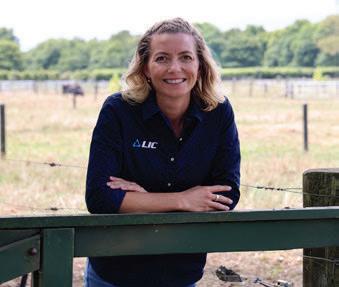
We’re proud to once again present a broad suite of genetics products, and our on-farm commitment remains unwavering: To provide farmers with tailored genetic solutions to drive farm profitability, offer lasting returns on your investment, and reduce your herd's emissions intensity - an essential consideration as our sector focuses more on sustainability.
So whether you are handpicking the sires yourself or combining the use of sexed semen and Forward Pack with short gestation and beef genetics, you're sure to find solutions to futureproof your farming operation.
Throughout this year's catalogue we've highlighted five carefully selected traits that make a real impact on your operation, including: milksolids, fertility, capacity, udder overall, and efficiency.
Our liquid sexed semen has achieved outstanding results this year, with 18-24 day non-return rates now within 1% of conventional fresh semen. This
progress means more farmers can confidently use liquid sexed semen to generate high-quality replacements from their top performing cows without compromising reproductive success.
Demand for Forward Pack genetics continues to rise as farmers reap the benefits of the latest technology to make even faster genetic improvement. By combining the proven reliability of Daughter Proven sires with the cuttingedge potential of elite genomic bulls, Forward Pack accelerates genetic gain, shortens the generation interval and delivers superior results.
Following the decision to retire our Premier Sires Jersey Daughter Proven team in 2024, LIC will be retiring the Premier Sires KiwiCross® and HolsteinFriesian Daughter Proven products in 2026. This follows a significant drop in demand for the Daughter Proven teams with close to 89% of our total Premier Sires inseminations now going to our Forward Pack teams, which includes a mix of the best Daughter Proven bulls along with elite genomic bulls.
We’re also thrilled to highlight the continued success of Short Gestation Length (SGL) semen which is proving invaluable on-farm. SGL genetics tighten calving patterns, reduce calving intervals and enhances reproductive performance. By allowing cows more recovery time before mating and increasing days in milk, SGL straws are a powerful tool in offering more days in milk and increased recovery time between calving and mating.
On the beef side, our expanded portfolio prioritises calving ease, colour marking and growth rates, providing genetics that deliver for New Zealand dairybeef production systems. Supported by partnerships with New Zealand’s best beef breeders and information coming out of MINDA and the Dairy Beef Progeny Test, these options are designed to provide additional value to your dairy operation.
Thank you for checking out our 2025 catalogue and for choosing us as your genetics partner.
We’re here to help you breed better cows, faster, so please do not hesitate to reach out to your Agri Manager to optimise your mating plans and maximise your genetic investments.
We hope you enjoy the catalogue and look forward to unveiling the Premier Sires teams later this year.
Here’s to a successful season ahead!


Herd improvement isn’t a new concept – we’ve been doing it for years.
468kg liveweight, 256kg milksolids
Over time the efficiency of New Zealand dairy cows has steadily improved. The cow of the early 1990’s produced 55% of its own liveweight in milksolids, whereas a cow of recent years produces about 81% of its own liveweight in milksolids.
2024
492kg liveweight, 400kg milksolids
It seems likely we’re going to be milking fewer cows in future, so we need to be milking the best ones.
The best cows are more efficient at turning feed into milk – they weigh relatively less, produce more, and have a fertility advantage. They also have a lower emissions footprint per kilogram of milksolids.
The goal is to breed from more of your top-performing cows and avoid breeding from your poorer performers –this helps ensure you have the most efficient and profitable herd possible.
Source: NZ Dairy Statistics.
While at the individual farm level there’s a wide and varied number of factors, it’s conceivable that by 2030 your whole herd could perform at the level of your current top-25% of cows.
Herd improvement is well within reach for every farmer: It can be achieved by focusing on four key pillars... Calves
We provide our farmers with great genetics and practical tools and data to improve their cow performance and get the job done. Our experience with genomic science gives us confidence that we can continue to deliver results for our farmers at a faster rate.
Good repro gives you choice - but is the result of a year-round approach.
Genetics
High-gBW bull teams, mated to the right cows, breed high-yielding, emissions-efficient replacements.
Heifer Management
Heifers that achieve liveweight targets at 15 months will get in-calf and calve faster. Those that achieve targets at 22 months of age are more likely to resume cycling early and conceive quickly as first calvers.
Calving Pattern
Strive for at least 88% of your cows to calve within the first six weeks of the calving season. This creates more days in milk and more time for cows to recover before mating.
Mature cows should reach a body condition score (BCS) of 5.0 at calving, while first- and second-calvers should aim for a BCS of 5.5. For mating, the target is for cows to lose less than 1 BCS from calving to mating (at mating, 4.5 BCS for first and second calvers, and 4.0 for mixed aged cows).
Healthy cows are more likely to perform well productively and reproductively, need fewer interventions and health treatments, and remain in the herd for longer.
Getting the herd back in calf quickly is like baking a ‘fertility cake’, with eight key ingredients listed below contributing to the mix at the right time throughout the year. For
To achieve strong conception rates, aim for 95% of early-calved mature cows to be inseminated within the first three weeks of mating, with short returns kept below 13%.
Proper insemination techniques and semen handling are critical for maximising conception rates. We carefully monitor the reproductive performance of our genetics products and technicians.
Provide one bull per 25 heifers plus a spare, and two teams of one bull per 30 non-pregnant cows plus spares for the milking herd. All bulls should undergo health and fertility testing before use.

For an average sized herd of 450 cows: A 2% increase in 6 week in calf rate, and a 1% decrease in empty rate = $8000 of potential profit.* Also expect:
• More AB heifer calves.
• More days in milk.
• Fewer service bulls.
• More voluntary culls.
“Before mating, if my animals are light and not cycling, we put them on once-a-day (milking). To me that’s a game-changer. You might sacrifice a little bit of production, but you get them back in calf.”

The best cows are more efficient at turning feed into milk – they produce more, weigh less, have a fertility advantage, and are more emissions-efficient.
*Best cows are the weighted average kgMS of all Q1 cows across the three breeds.
Crossbreed
Holstein Friesian
Jersey
Source: MINDA recorded herds throughout New Zealand, season-ending 2024, at least 150 cow herd size, all cows within herds must have recorded at least 120 days-in-milk. Data for all quartiles taken from individual herds across the country, and added together (eg: one farm may have 100 quartile one cows, while another farm may have 300 quartile one cows).
“In terms of genetic improvement within our herd, the number-one driver has been selection pressure, and by that I mean getting plenty of cows in calf and reducing wastage, enabling us to sell a portion of budget cows at the end of most years.”
Earl McSweeney, 765 crossbred cows, Canterbury.

The more information you have on an animal, the more confident you can be when making breeding and culling decisions.
Applying ‘selection pressure’ and being specific about what cows you are going to breed from results in faster genetic gain.
Farmers have a number of levers to pull:
Herd testing: Herd testing provides valuable information to help manage your herd and monitor milk quality and production. Herd test reports provide confidence you’re making the right calls and knowledge that you’re heading in the right direction.
Animal Health: We can provide you with more insights about your cows using milk and tissue samples. BVD, Johne’s Disease, Pregnancy Testing, mastitis testing, GeneMark Genomics.
MINDA records: Use MINDA to rank your herd on gBW, PW, and LW, and to produce reports such as the Selective Culling Guide, Herd Breeding Value report, and to check individual trait information available in genomic evaluations.

• Target the right cows to breed replacements from.
• Use replacement-quality semen on cows with the traits/metrics you desire, and use beef or short gestation length (SGL) semen on cows you don’t wish to breed milkers from; this will secure good genetic progress and is an efficient and sustainable use of resource.
Increase the rate of genetic gain by retaining your highest BW heifer calves to rear as replacements.
The calves you rear and grow as rising one-year-olds and rising two-year-olds this year will be the ‘engine room’ of your herd from 2027 and beyond.
The decisions you make, the records you maintain, and the management practices you apply during mating this year will directly affect the quality of the calves you rear next season.
Using GeneMark® Genomics, genotype information can be obtained soon after birth to better predict a calf’s inherited traits with greater accuracy than parent averages. This reduces the generation interval and boosts genetic gain.
Faster genetic improvement with genomics
“The power of genotyping a young calf is that a farmer has essentially the same reliability of information as they would have after a cow’s reached the end of her second lactation, with four classic herd tests across each lactation. So, that’s effectively 3.5 years earlier. For the farmer, this means more informed decisions on younger animals.”
Rachel Bloxham,
LIC herd improvement technical manager.

• To provide options and increase selection pressure, aim for 110% of required replacements each year.
“Our heifers are getting better every year, and we’re getting less passengers probably because we’re breeding from the top-half of the herd, and we’re culling hard on the heifers that don’t suit us or the system… they’re identified pretty quickly.”
Steve MacDonald, 380 crossbred cows, Taranaki.


• DNA parentage verification avoids mis-mothering.
• Drive genetic progress, and minimise herd replacement costs, by identifying and retaining calves with desirable genetic traits; GeneMark® Genomics predicts animal performance well before the heifer's first herd test (and the equivalent of an animal with two years worth of herd test data under her belt).

The most gains in BW are generated from sire decisions.
• Long term users of LIC genetics continue to outstrip long term users of ‘largely non-LIC replacement semen’ when it comes to the rate of genetic gain – these gains are cumulative and permanent, delivering long-term benefits into the future.
Genetic gain in New Zealand dairy herds
• All our catalogued bulls are carefully selected to boost productivity, enhance efficiency, and futureproof your farming business.
• The following pages in this catalogue offer customised solutions for every cow in your herd.
“For the first 21 days of mating I use up my sexed semen on the best seven cows each day, and the remainder of the really good cows go to Premier Sires (Forward Pack)…the rest will get a beef straw.”
Andrew Robb, 600 crossbred cows, West Coast.

Breed your highest-genetic-merit cows with elite LIC sires to accelerate genetic gain, while optimising returns from lower-merit cows.
Generate more heifer calves from your top performers, early!
Drive faster rates of genetic gain to maximise cow efficiency and meet emissions intensity reduction targets.
Our fresh-sexed Premier Sires(R) teams are expertly selected to drive improved cow efficiency and better herd improvement outcomes on farm.
Increase your herd’s genetic value with Premier Sires, a cost-effective and convenient way to mate your herd with New Zealand’s top bulls.
As an alternative to natural mating bulls, use SGL on all cows at the tail-end of mating, and use on cows that rank, for example, in the lower 20% of your herd on gBW. Tighten next season’s calving spread for both productivity and reproduction (fertility) gains.
More revenue through up to 12 extra days in milk.
• (12 days x 1.87 kgMS/day x $10.00 (forecast payout)= $224.40)
Select dairy-beef straws for use over lower-end cows to deliver calves with high beef genetic merit.
Aim for progeny that are easily identifiable, saleable, and meet financial management and sustainability targets for calf rearers, finishers, and beef processors.
Gain returns from non-replacement matings, whether it’s a valuable calf to sell or extended days in milk production
• Breed replacements from your highest genetic merit cows for improved herd performance.
• Increase efficiency of calf rearing with all replacements born early.
• Maximise value from lower genetic merit cows through extended days in milk (DIM) or beef revenue opportunities.
Maximise the potential of your top-performing cows to generate superior replacements.
How to Read a Dairy Sire Page
Bulls with standout attributes have these highlighted. The attributes are calculated within breed and based on 17/01/2025 information. It will also show if a bull is currently being marketed as a Premier Sire, and whether it is a Genomic graduate – having been previously marketed as a young bull. More information on page 161
A Milkfat gBV of 66 kg indicates that the bull will produce daughters which on average, are genetically superior to the base cow by 33kg of MF per 5t dry matter consumed.
A gBV of 3.4% indicates that 1.7% more daughters are expected to calve in the first 42 days of a herds calving period, compared to a bull of 0.
As an industry New Zealand has a tighter calving pattern than dairy industries worldwide. Highly fertile cows have been necessary to achieve this. It is generally accepted that the New Zealand base cow is far more fertile than any other country's base.
The likely percentage of cows surviving to the next lactation independent of culling for low production or poor fertility (For example a bull with a gBV of 4.3% means, on average, we expect his daughters to have a 2.15% higher probability of surviving to the next lactation than a bull with a gBV of 0).
A gBV of 0.00 indicates that the bull will produce daughters which on average, are genetically the same as the base cow. (For example by using a bull with a shed temperament of 0.01 the raw score for his daughters on average is expected to be 6.28 + 0.005 = 6.285 from a linear score of 9).
The stature gBV for a sire is comparing his progeny against the base cow which is across breed. Stature for Jerseys is usually negative and Holsteins are positive.
gBW/gBV are
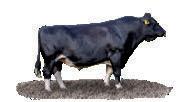
Using this bull at a gBW of $630 indicates that per 5t DM the replacements are expected to generate NZD $315 more net profit than using a sire with a gBW of 0.
The reliability percentage of a sire is a measure of the amount of information behind the bulls gBW. The higher the reliability the less movement expected with his gBW.
A gBV of 48kg indicates by using this sire over the average cow in New Zealand his daughters are expected to have a mature liveweight 24kgs heavier than the base cow of 503kg. You would expect the liveweight for Jerseys to be lower (negative gBV) and Holsteins to be higher (positive gBV).
A gBV of 578 litres indicates the bull will produce daughters which on average will produce 289 litres more than the base cow per 5t of dry matter fed. Remember the gBV is across breeds so Jersey and Crossbred animals may show a negative gBV.
This shows the value components in a bulls gBW that is contributed from either Production efficiency or Robustness. In this example the gBW is made up of $555 from Production efficiency and $75 from Robustness for a total of $630 gBW.
The difference between two sires of 0.5 gBV equates to a difference in expected daughter performance of 35,000 bulk milk count. The lower the SCC gBV the better.
A sires Calving Difficulty BV compares the percentage of assisted calvings expected when he is mated to yearling heifers and cows, compared to a bull of 0.
HoofPrint ®
Scan to learn about our environmental measure.

For updated bull information after each AE run, scan the QR code

Two-year-old daughter, Balantis Thunderstruck Owner: Harper Hill Limited, Matamata +gst

Breeding Details
Breeder S & E Hacker Sire Baldricks Spectacular MGS Woodwards Spot On


Breeding Details
Breeder A & R Vogels
Sire Julian Tu-Meke MGS Duggans Gameplan
Dam GMGQ-20-78 MGD GMGQ-18-60 gBW/Rel 595/64 gBW/Rel 562/67
PW/Rel 621/85 PW/Rel 565/88
KiwiCross ® F10J6
$621/54%

Breeding Details
Genomic Production gBVs
Other
Udder

Breeding Details
Breeder
KiwiCross ® F10J6

Breeding Details Breeder
Genomic Production gBVs
0.17
0.33
0.04
0.07
0.39
0.08
Overall 0.88
Conformation 0.29
KiwiCross ® F7J9

Breeding Details
Breeder
Sire Baldricks Spectacular MGS Dowson Honenui-ET
Dam Plateau Honenui Ginny MGD Plateau Beamer Gina

Breeding Details
Breeder P & D Lowe
Genomic Production gBVs
Genomic TOP traits
0.35
Udder Support 0.51
Front Udder 0.51
Rear Udder 0.78
Front Teat Placement 0.14
Rear Teat Placement 0.06 Teat Length -0.49 Udder Overall 0.67 Dairy Conformation 0.65

Breeding Details
Breeder Stony Creek Genetics
Sire Julian Multiplier-ET MGS Werders Premonition
Stony Creek

Breeding Details
Breeder K & R Julian
Sire Wiffens Centurion MGS Smiths Herald
Genomic Production gBVs
Teat Placement 0.34
KiwiCross ® F10J6
$544/47

Breeding Details
Breeder J & N Drysdale
Genomic Production gBVs
Genomic
Legs 0.05
Front Udder 0.82
Rear Udder 0.27
Front Teat Placement 0.37
Rear Teat Placement 0.35
Teat Length -0.31
Udder Overall 0.51 Dairy Conformation 0.32

Breeding Details
Breeder B & C Payne
Sire Browns Randy MGS Dowson Honenui-ET
Dam Paynes Honenui Pandora MGD Paynes Inspired Pandora
gBW/Rel 514/63 gBW/Rel 548/72
PW/Rel 447/74 PW/Rel 740/87
Genomic Production gBVs

Breeding Details
Breeder J & A Schouten
Sire Julian Tu-Meke MGS Tironui Superman ET
Dam Anjo Roxy MGD Anjo Rosie
gBW/Rel 659/61
576/55 PW/Rel 1089/57 PW/Rel 696/89

Breeding Details
Breeder B & C Payne
Sire Greenmile Rifl eman-ET MGS Speakes Slipstream ET Dam Paynes Slipstream Sally MGD Paynes Sally
gBW/Rel 577/65 gBW/Rel 791/77
PW/Rel 659/75
PW/Rel 1021/89

Breeding Details
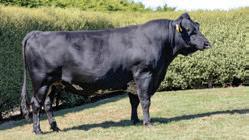
Breeding Details
Breeder A & A Benton
Sire Scotts BV Darius-ET MGS Okura LT Integrity Dam GVHK-17-5 MGD GVHK-12-516
gBW/Rel 498/64 gBW/Rel 348/52
PW/Rel 695/91 PW/Rel 656/88
Production gBVs

Breeding Details
Breeder B & C Payne
Sire Kainui
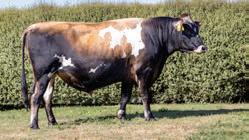
Breeding Details
Breeder Sulana Enterprises
Sire Tatawai Wrestler-ET MGS Julian Multiplier-ET
Dam Pukerimu JM Salamanca-ET MGD Pukerimu LT Suri-ET
gBW/Rel 559/66 gBW/Rel 533/80
PW/Rel 704/71
Genomic Production gBVs
PW/Rel 448/95

Breeding Details

Breeding Details
Breeder K & R Purdie
Sire Balantis TR Tonto-ET S1F MGS Arkans Brimstone-ET
Dam Kaiper Brimstone Trudy ET MGD Kaiper Hot Trudy
gBW/Rel 370/69 gBW/Rel 432/79
PW/Rel 409/96
Genomic Production gBVs
Adapts to Milking 0.02 Shed Temperament 0.02
Speed 0.07
Angle
0.58
0.01 Udder Support 0.53 Front Udder 0.49 Rear Udder 0.39 Front Teat Placement 0.51 Rear Teat Placement 0.97 Teat Length -0.78 Udder Overall 0.59
726/97

Breeding Details
Breeder A & S Bouton
Sire Roubroeks Air-Rifl e-ET MGS Bells Pierce
gBW/Rel 625/63 gBW/Rel 507/69 PW/Rel 506/70

Breeding Details
Breeder A Bulter
Sire Roubroeks Air-Rifl e-ET MGS Arkans Brimstone-ET
Taramont
gBW/Rel 516/69
PW/Rel 576/96
Production
Breeding
Breeder A & K Wiffen Dam Wiffens S-Keet Gem Sire Arkans Barrier MGS Lynbrook PS Solar-Keet






Individually $35.95+gst Pack
Breeding Details
Breeder J & S Sanson Dam Sansons Terrifi c Girl No9 Sire Glen Koru Proclaimer-ET MGS Lynbrook Terrifi c ET S3J
$35.95+gst Pack
Breeder S & S Gordon Dam Abba Park Gordons No. Five S0F
Sire Linan Integrity Winston MGS Gydeland Excel Inca S3F 519034 Gordons Flash-Gordon






Breeding
Breeder N & M Dowson Dam GNVV-15-2 Sire Greenwell Blackhawk MGS Braedene Manz Trumpet-ET Individually $35.95+gst Pack options available.
Breeding Details
Breeder Stony Creek Genetics Dam Stony Creek LT Nadia Sire Werders Premonition MGS Lynbrook Terrifi c ET S3J




Breeder B & C Payne Dam Paynes Tech Presley Sire Bells OI Floyd S3J MGS Tregaron Technician S2F Premier Sire Individually $35.95+gst Pack options
Breeding Details


Breeding Details
Breeder R & M Smith Dam CHNQ-17-338
Sire Bells OI Floyd S3J MGS Carsons Mecca Pulse S1F




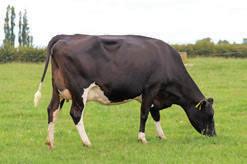

Two-year-old daughter.
G & R Milking Ltd, Whakatane
Breeder B & C Payne Dam Paynes Poppy Sire Arkans Balmoral MGS Paynes HH Prom-Queen






Individually $35.95+gst Pack options available.
Breeding Details
Breeder T & C Werder Dam BMWJ-13-65 Sire Priests Sierra MGS Marsden NN Excell ET
Production gBVs 12976 Daughters 1953 Herds
Individually $36.95+gst Pack options available.
Breeding Details
Breeder B & C Payne Dam Paynes AP Stellar Sire Speakes Slipstream ET MGS Arkans Patriarch-ET






Breeding Details
Breeder
Breeding Details
Breeder B & C Payne Dam Paynes Sonia Sire Meander TD Azure-ET S1F MGS Cawdor Pinnacle



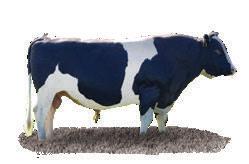


Breeding Details
Breeder
Breeding Details
Breeder B & C Payne Dam Paynes Sonia Sire Meander TD Azure-ET S1F MGS Cawdor Pinnacle

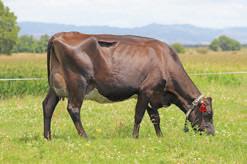


Breeding Details
• A2/A2
• Great udders
• Easier calving
Three-year-old daughter. Owner: Kaihere Farms Ltd, Ngatea
Breeder M & P Scott Dam Astrid Sire Burmeisters Bandana MGS Kraakmans Jaydie

• A2/A2
• Capacious daughters
• Outstanding fertility
Two-year-old daughter.

Breeding
•
Seven-year-old

Breeding
•
•

Breeding
Breeder M & J Ross
•

KiwiCross ® F9J7
gBW$428/97%REL

Breeding Details
Breeder G & G Bell
• A2/A2
• Phenomenal Udders
• Well liked by farmers
Four-year-old dam. Owner: G & G Bell, Te Aroha

Dam Pauline
Sire Shepherds Egmont-ET MGS Castlegrace Mako

For updated bull information after each AE run, scan the QR code
120003SCOTTS
123058
124027WAITARIA
124052
GASOLINE WAIRERE S3F
NB: the reliability of a team of bulls is always higher than using just one bull.
17/01/2025
Our Premier Sires teams are re-evaluated after each AE run. Scan the QR code to see our most up-to-date team.


Owner: R & A Bruin, Otautau

Breeding Details
Breeder R & A Bruin
Sire Mattajude BG Manu-ET S1F MGS Gordons AM Lancelot S3F
Dam Meander Lancelot Amy S0F MGD GMBP-15-212
Breed Split F16
Registered Pedigree (Supplementary)

Breeding Details
Breeder R & A Bruin
Sire Balantis TR Tonto-ET S1F MGS Tafts TT Offi cial-ET S2F
Dam Meander Official April-ET S2F MGD Meander FMI April S2F
gBW/Rel 393/72 gBW/Rel 435/93
PW/Rel 476/92 PW/Rel 933/91
Genomic Production gBVs
Breed Split F16

Breeding Details

Breeding Details
Breeder
Sire Prattleys Lucid Free-Style S1F MGS Glenmead SB Trapeze S1F
Dam Bagworth Trapeze Bella S1F MGD Bagworth
gBW/Rel 509/62 gBW/Rel 385/52
PW/Rel 451/72
Genomic Production gBVs
PW/Rel 457/72
Breed Split F16
Registered Pedigree (Supplementary)

Three-year-old dam Owner: Maharee Farms Ltd., Taupiri
Breeding Details

Breeding Details
S3F
gBW/Rel 521/66 gBW/Rel 426/71
PW/Rel 591/91 PW/Rel 955/90

Breeding Details

Breeding Details
Breeder Poplar Partnership Ltd. Sire Mill-RidgeMFGentleman-ETS1F MGS Greenwell GR Governor S1F
Dam Waitaria Governor Kia-ET S1F MGD Waitaria Beamer Kara S2F gBW/Rel 519/63 gBW/Rel 495/70
PW/Rel 359/72 PW/Rel 514/91
Genomic Production gBVs
Breed Split F16
Registered Pedigree (Supplementary)

Breeding Details Breeder

Breeding Details
Breeder R & J Millner
Sire Paynes LR Pacman-ET S2F MGS Greenwell GR Governor S1F
Dam FWPF-20-29 MGD FWPF-15-12
gBW/Rel 489/66
PW/Rel 513/91
Genomic Production gBVs
gBW/Rel 445/66
PW/Rel 693/92
Breed Split F16
Registered Pedigree (Supplementary) $477/58% REL gBW

Breeding Details Breeder
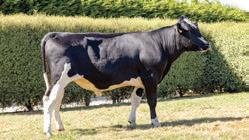
Breeding Details
Breeder John Harrison
Sire Lightburn Saq Gasoline-ET MGS Lightburn Blade Gusto Dam Busybrook Gusto Lass S2F MGD Busybrook Beamer Lass S1F gBW/Rel 645/67

Breeding Details
Breeder B Wells
Sire
Dam Busybrook Svrr Oli-ET S1F MGD Busybrook G Ollie-ET S0F gBW/Rel 616/62
Breed Split F15J1
Registered Pedigree (Supplementary)
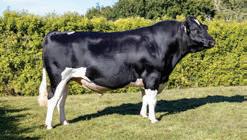
Breeding Details
Breeder Waiari Holdings Limited Partnership
Sire Spring River GG Spyro S1F MGS Arkan MGH Backdrop-ET S2F
Dam Waiari B Pottinger MGD MQFR-15-24
gBW/Rel 314/65
PW/Rel 544/91
Genomic Production gBVs
gBW/Rel 262/59
PW/Rel 415/96
Genomic TOP traits
Breed Split F16
Registered Pedigree (Supplementary)
$494/57 %

Breeding Details

Details


Eight-year-old-dam,
Breeding Details
Breed Split F16
Registered Pedigree (Supplementary)

Breeding Details Breeder
Front Udder 0.61
Front Teat Placement 0.34
Rear Teat Placement 0.48
Breed Split F16
Registered Pedigree (Supplementary)

Breeding Details
Breeder K & F Clark Sire Wittenham CP Pollman-P S1F MGS Greenwell GR Governor S1F
Genomic Production gBVs
Breeding
Breeder








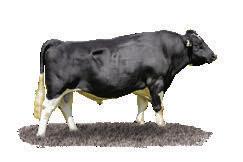


Individually $35.95+gst Pack options
Breeding Details
Breeder J & J Bellamy Dam DWNK-16-30
Sire Dicksons BG Mandate S1F MGS San Ray FM Beamer-ET S2F






Breeding Details
Sire Meander
Pedigree (supplementary)
Breeder G A Wilson Dam Telesis Backdrp Honor S2F
Sire Wittenham MG Alpine S2F MGS Arkan MGH Backdrop-ET S2F




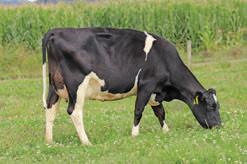

Breeding
Breeder
Breeding
Breeder









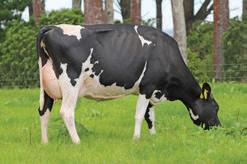
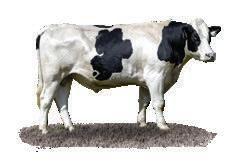





Breeding
Breeder
Sire Meander SB Arrow-ET S2F MGS Dickson BC Mandate S1F





Breeding Details Breeder


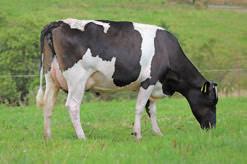



Breeding Details







Breeding Details Breeder





For updated bull information after each AE run, scan the QR code
324023 ROSSUM LOTTO
Our Premier Sires teams are re-evaluated after each AE run. Scan the QR code to see our most up-to-date team.
324018 BENWORTH TM GRIFFINPOLL-P JC15
323008 TIRONUI BUZZ ZAZU
323033 GLENHAVEN BRISBANE LONIC
323050 PHILSAN ROXTON DATSUN
323047 LYNBROOK BERKLY ORYX
324001 KAIMATARAU NOVAK GOBLIN
323004 RIVERINA BAS ACHILLIES-ET S2J
324024 FREYDAN NOVAK ICONIC
323046 LYNBROOK TITUS SANTANA 324021 CAWDOR MATCH ON SUNDAY S3J
323206 LYNBROOK TN TE ANAU
Our Premier Sires teams are re-evaluated after each AE run. Scan the QR code to see our most up-to-date team.

Two-year-old Brisbane daughters. Owner: Puketaha Farming Enterprises



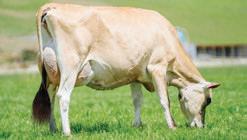

Five-year-old dam. Owner: Busybrook, Oamaru
Breeding Details Breeder Busybrook
Glenui Super Lamar MGS Glenui Degree Hoss-ET
Upland Park Hoss Bloom MGD Upland Park LT Bloom


Breeding Details
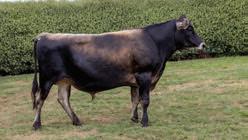
Breeder

Breeding Details
Breeder Pedley Family
Sire Thornwood Profi t Novak MGS Braedene PAS Triplestar
Dam Kaimatarau Triple Gild MGD Kaimatarau Bishop Gild
gBW/Rel 494/66 gBW/Rel 339/55
PW/Rel 662/89
424/89
Breed Split J15F1
Registered Jersey (Jersey Cross)

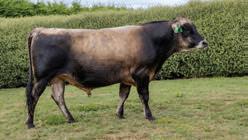
Details


Breeding Details Breeder B Dyson

Breeding Details
Breeder F & C MacBeth

Breeding Details
Breeder Bradshaw Monks Limited
Sire

Three-year-old dam. Owner: Ede Investments, Taupiri
Breeding Details
Breeder M & J Gibb
Sire Lynbrook PC Buzz ET MGS

Breeding Details


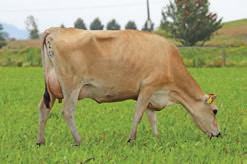


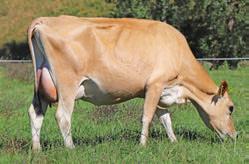
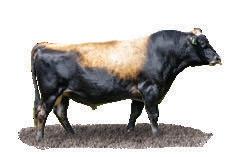


Breeder





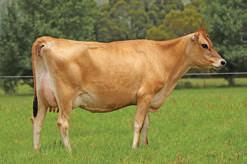
Breeding Details







Breeder M & J Gibb Dam Tironui Integ Meg Sire Glanton SS Bastille S3J MGS Okura LT Integrity

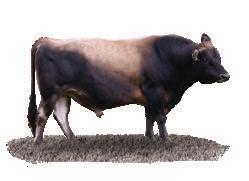






Breeding Details
Sire













For updated bull information after each AE run, scan the QR code


Breeding Details
Production gBVs 82 Daughters 23 Herds
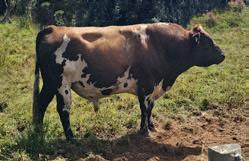

Two-year-old daughter Owner: G & J Glenworth, Hawera
Production gBVs 42 Daughters 12 Herds
Breed Split A16
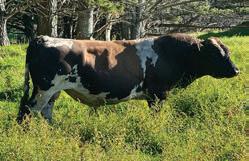

Breeding Details
Breeder Ackermann Ltd Dam Musica 13-25 Sire Sanrosa Dynamite ET MGS Carmelglen Brody LIC Initiatives
Production gBVs 50 Daughters 13 Herds




Milking Shorthorn
Registered Pedigree (Supplementary)
A2/A2
Breeding Details
Breeder Red Cow Farms Ltd
Brecon VVV Fantasy S0S
Sire Brecon Hurricane S0S MGS VR Viking Viljar Vario Blend SHM 6, AYR 5, DAR 2, SWR 2, FRI 1
Milking Shorthorn
Registered Pedigree (Supplementary) A2/A2
Breeding Details
Breeder Red Cow Farms Ltd
Sire Brecon Hurricane S0S MGS Brecon Mahe S0S Blend SHM 11, NWR 2, AYR 1, FRI 1, SWR 1
Milking Shorthorn
Registered Pedigree (Supplementary)
A2/A2
Breeding Details
Breeder Red Cow Farms Ltd
Sire Brecon Dylan S1S MGS VR Hel P Blend SHM 3, DAR 8, SWR 3, AYR 1, FRI 1
Milking Shorthorn
Registered Pedigree (Supplementary)
A2/A2
Breeding Details
Breeder Red Cow Farms Ltd
Sire VR Bogar P MGS Brecon Zachary S1S Blend AYR 9, FRI 3, SWR 2, SHM 1, NWR 1




Brown Swiss Registered Pedigree (Germany)
Breeding Details
Sire Cadence Dam Evita
MGS Viper A2 A2/A2
Brown Swiss Registered Pedigree (Germany)
Breeding Details
Sire Andaman Dam Donni MGS Hegall A2 A2/A2
Brown Swiss Registered Pedigree (Germany)
Breeding Details
Sire Pirol Dam Valerian MGS Frieda A2 A2/A2
Brown Swiss Registered Pedigree (Germany)
Breeding Details
Sire Amorie Dam Cadence
MGS Kora A2 A2/A2

To learn more about our Focus Team options, scan the QR code
^RecessiveFertilityGenecarrier #RedFactorCarrier
*Seepricingonpage163
LIC has updated its High Input Index to include a focus on a range of traits alongside breeding worth to identify animals best suited to high input systems. Those traits include: Capacity, Udder Support, Udder Overall and Protein.
What makes up LIC’s High Input Index?
The graph shows the weighting of the traits within the High Input Index, in addition to the existing eight traits of gBW.
gBV Protein - 21.5%
gBV Milkfat - 21.5%
gBV Milk Volume - 8.5%
gBV Liveweight - 9.5%
gBV Fertility - 15.0%
gBV SCC - 3.5%
gBV BCS - 2.5% gBV Capacity - 2.0%
gBV Udder Support - 10.0% gBV Udder Overall - 6.0%
How do I interpret the High Input Index?
The High Input index allows two animals to be compared based on their suitability to the system. Unlike gBW & PW, it does not represent an economic value of the animal’s productive performance or ability to breed profitable replacements.
Through the Resilient Dairy Programme, we have developed a facial eczema breeding value to enable farmers to breed cows that are more resistant to the disease.
This research has allowed us to identify bulls in our breeding schemes whose daughters are less susceptible to facial eczema due to having lower responses of GGT – an enzyme that is released into the bloodstream by the injured liver when animals are affected by facial eczema.
Facial eczema is caused by a pasture-based fungal toxin (sporidesmin) that when ingested, causes liver damage, decreased milk production, skin irritation, peeling, and in severe cases, death.
Facial eczema is a distressing disease that impacts thousands of cows each year, costing the New Zealand dairy sector at least $100 million annually in lost production.
Only a small portion of animals with the disease show clinical signs, making it hard to assess the extent of the problem.
There is no cure for facial eczema, so prevention and management is currently the only way of protecting animals. This can include monitoring pasture spore count, and either dosing animals with zinc, or spraying pastures with a fungicide.
Breeding cows that are more tolerant to facial eczema is a solution to reduce the impact from the disease long term, and when used over generations, farmers can reduce their herd’s susceptibility.
For more information about the Resilient Dairy programme or to volunteer your herd for further facial eczema studies, please email resilient.dairy@lic.co.nz or visit the LIC website.
Seepricingonpage163

For updated bull and pack information after each genetic evaluation run, scan the QR code
Non-Replacements: Every Cow has a Purpose
4 key management decisions
More days in milk plus improved cow fertility
Consider:
SGL Dairy to maximise days in milk and fertility benefits next season
Focus on:
SGL Dairy solutions.
Saleable calves without impacting days in milk or fertility
Consider:
SGL Beef to reduce gestation length and produce a saleable calf
Focus on:
SGL Hereford and SGL Angus options.
2 1
Saleable calves plus high beef value finishing cattle
Consider:
Beef to improve returns for rearers, finishers and meat processors.
Focus on:
Individual Beef Sires and Focus Packs.
Consider:
Individual beef sires or Focus Packs for performance. Select for growth, heavy 600 Day Weight and also muscling and marbling –important to processors.
Focus on:
Beef Significance EBVs. Within-breed EBVs (600 Day Weight, carcase weight, eye muscle area and intramuscular fat). Dairy Progeny Tested sires whose progeny should grow on to target weight targets.
Consider:
3
The beef breed that gives you a solid return in your area. This might be for well-marked and well-grown calves.
Focus on:
Local calf sale prices, expected coat colour info and data from the Dairy Beef Progeny Test.
Talk to your Agri Manager to design a mating plan for your herd.
Consider:
4
Individual beef sires or Focus Packs that give you the combined benefit of calving ease and gestation length for your herd.
Focus on:
Dairy Significance EBVs. (Calving Ease, Birth Weight and Gestation Length), MINDA® data and DBPT measures can all help minimise risk.
Genetic improvement is about mating ‘the best with the best’ to produce the most efficient and profitable future herd. But what about the rest?
If you don’t select the right genetics to ensure you’re making the best possible returns from next years’ calving, you could be leaving money on the table.
Every cow has a purpose. The current higher milk payout climate coupled with strong demand for beef-cross calves, means cows not inseminated with replacement straws should still generate revenue and contribute to the bottom line.
Two AB options are either inseminating using the best available beef sires to produce a saleable beef x dairy calf or using Short Gestation Length Dairy (SGL Dairy ®) straws to maximise days in milk and improve fertility.
Increasingly both Beef and SGL Dairy straws are being used in mating plans.
Over the past few years, many more herds are adopting a ‘Beef Up Front’ mating strategy with beef straws inseminated to lower BW cows on day one of mating. Bigger and earlier calves are hitting the saleyards, fetching good prices.
We select our beef sires from some of the top breeders in the country. Without exception, every bull has been selected for the combination of traits they deliver. They are the total package to improve profitability for the dairy farmer, but also have the growth and carcase for finishing and processing.
This year we have introduced the British Blue breed. From Cogent Breeding Ltd in the UK, British Blue are popular
Every Cow has a Purpose
among UK dairy farmers for producing identifiable, vigorous, solid calves.
All breeds have straws available in Focus Packs. These packs contain straws from both proven sires and younger, unproven bulls.
Using SGL Dairy can provide up to 10
Most of our beef sires in the 2025 catalogue are sourced from these well-respected and performanceoriented New Zealand breeders.
days extra milk, while increasing the chance of cows getting back in calf early. In today’s payout climate, an extra 10 days in milk results in about $224 more milk revenue per cow.
Talk to your Agri Manager to get the most value from non-replacement straws.

Beef + Lamb New Zealand (B+LNZ) Genetics and LIC have worked together to fulfil growing demand for quality beef genetics suitable for New Zealand dairy cows. The B+LNZ Genetics Dairy Beef Progeny Test (DBPT) aims to improve the quality of dairybeef animals in the industry by identifying and enabling wider use of elite bulls for producing dairy beef.
The DBPT began in 2015 and now has nine years of data, collected on 5300 beef x dairy progeny sired by 194 beef bulls from 19 different beef breeds.
From the moment they are born, beef x dairy calves in the Progeny Test are measured for birth weight, gestation length and the time taken to reach a weaning weight. From there, live weights are measured at key intervals. Carcase weight, marbling and other meat quality traits are recorded on all animals. All data is independently analysed by researchers from the School of Agriculture and Environment at Massey University.
In this years’ catalogue, several bulls have data from the programme. These individually nominated sires have been stamped with an LIC ‘Dairy Progeny Tested’ label. These bulls, representing Angus, Murray Grey, Hereford and Charolais are among the top graduates from the Dairy Beef Progeny Test.
These results, from January 2025 data, summarise performance of the beef x dairy progeny of beef sires in the progeny test. The bulls selected to enter the progeny test are generally
‘better than average’ for traits of dairy importance (in particular, birth weight and gestation length). The graphs on this page are representative of these highly selected cohorts of bulls rather than their breed in general.
Breed averages are only shown for breeds with more than four sires per breed. Note that only a few breeds are represented for carcase weight and marbling. These data are still arriving. For the traits of dairy importance, lower values are sometimes desirable, so breeds with lighter calves, short gestation length and fewer days to reach weaning weight are grouped at the left of these three graphs. For traits of beef importance, breeds with heavier yearling weights, higher carcase weights and increased marbling scores are shown on the right of those three graphs.
All results from this test are available online https://www.blnzgenetics.com/ progeny-tests/beef-progeny-tests LIC thanks Beef + Lamb New Zealand (B+LNZ) Genetics for their foresight and on-going support of this programme.

These graphs summarise progeny records from catalogued LIC beef sires mated over New Zealand dairy cows. This data is from either 2022 or 2023 inseminations and do not necessarily reflect bulls in the 2025 catalogue. Please use these results as a guide only.
Calving Difficulty
More than 30,000 MINDA calving difficulty records in 2024 were summarised by breed. The table below shows the breed average, maximum and minimum level of calving difficulty (number of calves requiring some
form of assistance divided by total calvings for that breed). Note: Only LIC catalogued beef sires that each had 100 progeny calving records in 2024 were included in this analysis.
Beef sire breed calving difficulty when mated over NZ dairy cows. Breed average, lowest and highest bull are shown
Source: 2024 LIC MINDA records.
Gestation Length
This gestation length chart is from LIC’s MINDA database of spring 2023 and spring 2024 calvings. More than 300,000 gestation length records were analysed. Results are for beef breeds represented by four or more (LIC catalogued) bulls per breed. Each bull had more than 100
progeny gestation length records.
The gestation length charts show the average gestation length of beef sires (for each breed) when mated to NZ dairy cows. The highest and lowest gestation length bulls are shown.
Beef sire breed gestation length when mated over NZ dairy cows. Breed average, lowest bull, and highest bull, are shown
Source: 2023, 2024 LIC MINDA records. NZ dairy base gestation length is 282 days.
How to Read a Beef Sire Page
Average gestation lengths of the sire’s dairy beef progeny is displayed for bulls that have average gestation lengths from the B+LNZ Genetics Dairy Beef Progeny Test, or reliable MINDA® gestation lengths based on recorded calvings.
The polled gene is dominant and carriers are born without horns. Homozygous polled (“100% polled”) bulls will always produce polled offspring, whereas 50% of offspring from heterozygous polled (“50% polled”) bulls will have horns, when mated to a horned animal.
Breeder: Example Breeder Individually

Calving Ease (%) EBVs are based on calving difficulty scores, birth weights and gestation lengths of pure beef progeny. More positive EBVs are favourable.
Gestation Length (days) EBVs estimate the length of pregnancy for a sire’s progeny. More negative EBVs indicate shorter gestation lengths.
600 Day Weight /Yearling Weight EBVs are based on a sire's purebred progeny weights at this age. More positive EBVs indicate heavier progeny (faster growth).
Intramuscular Fat (%) EBV (also known as marbling) estimates the genetic difference in the % of intramuscular fat at the 12/13th rib site in a standard carcase. More positive EBVs are usually favoured.
% Rank indicates how good or bad a sire is for a trait. Lower values indicate superior bulls. For example a % rank of 5 indicates that they are in the top 5% for that trait, and better than the other 95% of sires.
Genetic Evaluation These are within-breed evaluations. Withinbreed evaluation EBVs and rankings can only be compared for bulls of the same breed.
DPT Bulls that have the "DPT Dairy Progeny Tested" stamp on their photo have been a part of the Beef + Lamb NZ Dairy Beef Progeny Test.
Birth Weight For bulls that have been used in the B+LNZ Genetics Dairy Beef Progeny Test, the average birthweights from their dairy beef progeny is shown.
Calving Difficulty is available only for sires with 100 or more beef x dairy progeny born in the past year and recorded MINDA®. For each sire, the average percentage of calvings that showed any difficulty is shown.
Red Carrier Red coat colour is recessive to black, so bulls can carry red coat colour without expressing it. If red carriers are mated together then red calves are possible.
Dilution Carrier Some breeds can carry the dilution gene which is dominant. It dilutes black base coats to grey/silver and red coats to gold/yellow.
Birth Weight (kg) EBVs are based on the recorded birth weights of a sire’s purebred progeny. Lower EBVs indicate lighter calves.
Carcase Weight (kg) EBVs are based on a sire's purebred progeny weights at the time of slaughter. More positive EBVs indicate heavier carcases.
Eye Muscle Area (sq cm) EBVs estimate muscling. More positive EBVs indicate progeny are likely to be more muscled and have more higher-value cuts of meat.
With more days in milk, better cow fertility and not managing natural mating bulls, the SGL Dairy benefits add up.
Non-replacement Mating
1. Creaming it with More Days in Milk
Maximise value from lower genetic merit cows through extended days in milk by using Short Gestation Length (SGL) bulls, which can reduce gestation by up to 12 days.
And the sooner the cow calves, the sooner she'll be back in the shed making milk.
Increasing days in milk is one of the most effective ways to improve productivity, increasing kilograms of milksolids (kgMS) per cow.
The Days In Milk Opportunity
12 extra days milking per cow at 1.87kg MS/day and a $10 payout = $224 per cow.
If 80 cows calve to SGL, that’s $17,920 extra income.
Multiple Fertility Advantages
A tighter calving spread means more recovery time between calving and the planned start of mating. This reduces late-season challenges, minimises interventions, and simplifies workload.
Earlier-calving cows have more time to start cycling and regain BCS before mating, improving conception rates and the six week in calf rate. Lower empty rates provide a greater chance of discretionary culling. Overall, this results in a more efficient, productive herd.
Artificial breeding also reduces the risks and costs associated with bull fertility, biosecurity, staff health & safety, performance breakdown, and farm damage. Replacement AB
Save your efficient, highly productive, and high BW cows. Tactical use of SGL can help save a high merit cow which has cycled late this season, meaning her calving can be brought forward into the replacement AB window next season. This helps maintain optimum herd age structure and productivity.
3. No bull – fewer hassles
SGL semen is a cost-effective alternative to using natural mate bulls during the tail-end of mating. SGL straws are usually a more costeffective option compared to leasing, purchasing, and feeding run bulls.
Farmers throughout New Zealand are leveraging SGL semen to maximise herd productivity, improve profitability, and streamline calving management.
Whether it's getting late-calving cows back-on-track or optimising whole herd performance, Short Gestation Dairy is a proven, results-driven solution.
The popularity of LIC’s short gestation length semen has never been so high, with the most recent season (2023-24) delivering nearly 2 million extra days in milk across the industry. Nationally, that’s around $37m of extra farmer income.
Tactical use of replacement and non-replacement straws can help you achieve your herd improvement goals, as well as increase income the following year.
Using Beef and SGL Dairy ® straws together in a mating plan helps ensure you effectively increase returns from using Sexed Dairy, Premier Sires® and Alpha® straws.
Example 12-week mating plans
Your Agri Manager can help design a mating plan specifically for your herd. Your LIC AB Technician will confirm your plan with you with a ‘Pre-Run meeting’ prior to planned start of mating.
"The use of SGL semen can be a real game-changer. We often have herds where their 6 week in calf rate will start at 67%, but the use of SGL means their expected calving pattern tightens to a 75% 6 week in calf rate. This genuinely accelerates herd reproductive improvement. Couple this with the ability to extend the mating period by 10 days (with the same calving period), and you have a tool that can also drop empty rates by 1-2%. Farms using wearables and adopting SGL can pay for their collars, just by dropping bulls and heat aids coupled with the extra days in milk. All the other gains are a bonus!"
Ryan Luckman BVSc (Dist) MANZCVS (Vet Epi), Veterinary Centre Waimate


Short gestation length beef sires that deliver more days in milk, together with fertility benefits (compared to many other beef breeds). SGL Hereford is LIC’s top beef breed, offering distinctive white-faced calves, which are both easy to identify and sought after in saleyards. A high proportion of SGL Hereford sires are homozygous polled. LIC sources genetics from Shrimpton’s Hill Herefords, Australasia’s leading SGL Hereford stud which is known for breeding traits ideal for the dairy industry. Available in liquid or frozen semen options to suit different farming systems.
SGL Hereford Focus Pack (contains heterozygous and homozygous polled bulls)

Coat Colour Possibilities:



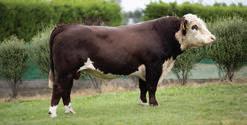


A new generation of highly-selected Hereford sires, specifically chosen for excellent calving ease, growth, and outstanding carcase and meat quality traits. LIC has deliberately selected two of the best young sires available, as well as a Dairy Progeny Proven sire. The go-to choice for well-marked calves that will reliably perform through the entire dairy-beef value chain from rearing, finishing, and carcase.
From the Paterson family in Waikaka, Gore, Redford is LIC’s number one pick among 2022-born Hereford bulls. He boasts figures that are in the top 4% of the breed for calving ease, and the top 15% for gestation length. His growth and carcase figures stack up, with his 400 Day Weight in the top 10%, and a carcase weight in the top 1%. He ranks in the highest 0.2% of the breed in the NZ Hereford Dairy Index. His progeny should be born easily, grow fast, and yield well. Hereford Focus Pack (homozygous polled)
Waikaka Herefords






Breeder:
In Time is an outstanding proven six-year-old bull. His Birth Weight EBV puts him in the best 5% of the breed. His Carcase Weight and Eye Muscle Area EBVs both rank him in the top 20% and top 9% of the breed respectively. These figures indicate his progeny will be born easily and will continue to grow well through to slaughter and yield well. These outstanding features came through in his B+LNZ Genetics Dairy Beef Progeny Test results. He made the Dairy Beef Progeny Test top 20 all-rounder list; he was one of the few bulls tested over the nine years that ranked highly for both dairy and beef performance traits.

Breeder:
Washington was LIC’s pick among 2023-born Hereford bulls. His spread of EBVs are almost unmatched. He ranks in the top 4% of the breed for calving ease and is among the shortest 15% for gestation length. His 400 Day Weight and Carcase Weight EBVs place him in the top 4% and top 2% of the breed – indicating he’ll produce well-grown progeny and heavy carcases. His eye muscle area and marbling EBVs are both in the top 4% of the breed –providing a unique muscling and marbling combo. An extremely rare genetic package – he scores well within the top 1% of the breed for dairy-beef value.


Backed by Cogent Breeding Ltd’s large, scientific breeding programme and sire proving scheme in central England, British Blue has been selectively bred in the UK for its suitability to modern dairy-beef farming systems. These cattle are medium to large-framed, and most-noted for double muscling which results in a high meat-to-bone ratio. Crossing British Blue sires with dairy has become increasingly popular in the UK due to improved carcase quality, high growth rates and efficiency, ease of calving, and short gestation length.
The two nominated sires presented in this catalogue have been mated over LIC-bred dairy cows managed in a grazing environment in the UK. In general, the dairy-beef progeny from these bulls showed very short gestation lengths (up to 275 days) with birth weights and calving difficulty the same as the average of all beef breeds when mated to New Zealand sired dairy cows.
British Blue-cross calves exhibit excellent muscle development, higher meat yield, and superior conformation compared to other dairy-beef calves. They show fast growth rates, good feed conversion, and frequently meet target weights quicker than other breeds – with a larger, heavier, carcase. This makes them profitable for rearers and finishers, and highly desirable for the beef market. Despite their muscularity, British Blue sires used for dairy crossbreeding are carefully selected for calving ease, reducing the risk of complications in dairy cows (recommended for mature cows only).
British Blue was developed from the Belgian Blue in the UK but selectively bred for a more moderate muscle structure, improved management traits such as calving ease, and adaptability to modern farming systems.
Traits:
• Calf quality % is a visual appraisal of conformation and fleshing ability, and is expressed as the percentage of progeny who are average quality or above.
• Calfvigour is the offspring’s vitality and potential to thrive in the first 24 hours of life.
• Calving difficulty % is based on a 1 to 5 scale of calving ease; this displays the percentage of calves that required moderate assistance to be born.
• B lue roan % is percentage of Light Blue, Blue and Dark Blue Roan calves, with the remainder being White, or Black and White.
• Triple Mix Straws contains sperm from three different sires in the same straw. Polaris and Rockstar are in Triple Mix straws. Triple Mix sires are selected on management traits. Three sires are included in each mix, these sires are short gestation, easy calving and produce progeny with low birthweights. This is done to ensure that Triple Mix products can be used confidently across the herd.



Breeder: Cogent Breeding Ltd. Individually $23.30+gst
Both Polaris and his half-brother Rockstar have been progeny tested on LICbred dairy cows managed in a grazing environment in the UK. He is Cogents leading gestation length British Blue sire at just 276 days average gestation when mated to dairy cows in a grazing environment. His progeny are born easily, moderately framed, with high vigour. Polaris is the go-to choice for those emphasising management traits, while wanting to maintain quality.

Breeder: Cogent Breeding Ltd. Individually $23.30+gst
CBL Rockstar is an exciting British Blue sire with a gestation length of 278 days when mated over UK dairy cows. He continuously produces highquality calves, with a calf quality score of 99.4%, indicating his progeny display excellent conformation and natural fleshing from birth. His calves show good vigour and growth.


Nationwide, there’s a high demand for calves that grow rapidly and maintain exceptional weight gains. LIC’s Charolais offer excellent colour-marking options and exceptional dairy-beef progeny performance. Consistently popular, Charolais has seen the greatest increase in demand for beef straws in each of the past four years. LIC-selected sires are true breed outliers for calving ease, moderate gestation length, growth, and heavy carcase weights.
Charolais Focus Pack

Charolais calves showing variance of possible coat colours

Breeder: Kakahu
One of the most impressive looking Charolais bulls we’ve seen, and much admired by visitors to LIC’s bull farm. Apollo’s EBVs match his amazing phenotype. Within the NZ Charolais evaluation, he’s in the top 5% for Calving Ease and top 15% for Gestation Length. His growth figures place him in the top third of the breed and his eye muscle area is in the top 5%. Like Milestone, he’s a ‘go-to’ option for calves that will grow through to heavier weights and will command attention in the marketplace. From 2024 MINDA calving records, he was one of the more reliable calving ease Charolais bulls.

Milestone continues to set the standard for Charolais. His results from the B+LNZ Genetics Dairy Beef Progeny Test sees Milestone ranked 12th of 170 sires for his beef x dairy progeny to reach Weaning Weight in the shortest timeframe (76 days). Milestone’s beef x dairy calves had a lighter Birth Weight than the 11 sires above him, and he had a shorter gestation length than all but three of them. Milestone is a true outlier. Within the NZ Charolais evaluation, he’s in the top 1% for Calving Ease and for Gestation Length. His growth figures place him in the top 1% of the breed for Yearling Weight and top 5% for Carcase Weight.
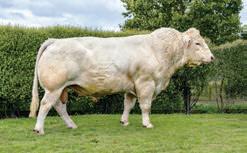

Homozygous polled and solid-coloured homozygous black. From Rissington Cattle Company, the Profit Maker breed is highly selected for calving ease, growth, feed efficiency, and carcase traits (marbling and yield). The breed combines hybrid vigour and complementary breed traits, and is supported by the Leachman Global Multibreed Analysis of 1.5 million animals and carcase testing of 10,000+ beef x dairy crosses. Profit Maker ® Focus Pack


Expedite is a short gestation, homozygous black, homozygous polled, Profit Maker ® sire that is a genuine outlier for all the traits that matter to the dairy farmer and beef finisher. On the Leachman Global Multibreed Analysis, it’s no surprise Expedite ranks highly across all breeds for $Dairy ® Index, given his place in the top 1% for Gestation Length, Birth Weight, Carcase Weight, marbling, and feed to gain.

Reliant is a standout Profit Maker ® sire that is homozygous black and homozygous polled. He’s in the top 2% of the breed for Gestation Length and marbling, top 2% for Weaning Weight and Carcase Weight, and top 30% for Birth Weight. Like Expedite, he has superb, documented, feed efficiency. Reliant also sits in the top 1% for $Dairy ® Index and has been used extensively in the New Zealand dairy sector over the last two years.





Naturally polled and black, ensuring uniformity and easier management, LIC selected Angus sires have proven highly reliable for calving ease (MINDA® records), and consistently show the shortest gestation lengths of any beef breed. These Angus sires exhibit good growth with an ability to finish and grade well, with proven marbling performance. These animals are bred by AngusPRO members, who use cutting-edge genetic evaluation, large datasets, and genomic information to achieve high rates of genetic gain. Straws are offered as individual sires or via the SGL Angus Pack and Angus Focus Pack.
Breeder: Kakahu Angus Individually
Waitangi Opportunity is LIC’s number one pick of all 2023-born New Zealand Angus bulls. He’s a moderately framed bull, naturally thick and well-muscled, with an excellent temperament. His breed data puts him in the top 3% of the breed for Calving Ease and top 2% for Gestation Length. His EBVs suggest his progeny should have explosive growth (top 11% for 600 Day Weight), combined with great carcase characteristics (Eye Muscle Area and marbling in the top 15%). This combination ranks him in the top 1% in the Australasian Angus Dairy selection index, making him a prime sire option for any dairy-beef production system.

Project’s results from the Dairy Beef Progeny Test are in and they are outstanding. Of beef sires (representing multiple breeds) evaluated in his year, Project ranked first for shortest Gestation Length (277.9 days) and first for low Birth Weight (34.5kg). Proving to be a true curve-bender, he ranked fourth for 200 Day Weight and seventh for 400 Day Weight. These figures are backed by all-round impressive BREEDPLAN EBVs from calving through to growth and carcase. Project is a true Dairy-Beef specialist.

We believe Solution is one of the best Angus bulls available anywhere today. This bull excels for both dairy farmer and beef finisher profitability. Within the Trans-Tasman Angus Cattle Evaluation, he ranks in the top 1% of the breed for Calving Ease, short Gestation Length, and low Birth Weight. He is at breed average for growth and ranks well for both muscling and marbling.
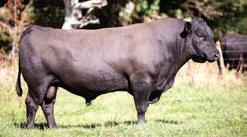
Bred by Rissington Cattle Company in Hawke’s Bay, Paradox had less than 1% of his 2024-born beef x dairy progeny that required calving assistance, (evidence of among the lowest rates of Calving Difficulty of any beef sire). A popular and proven sire for both Calving Ease and days in milk, Paradox also delivers growth data and great carcase figures that are within the top 10%. It’s no surprise he was among the highest ranking of all Rissington bulls on the $Dairy ® Index.



This breed offers exceptional weight gain, with Simmental crosses reaching weaning weight the fastest, and showing the heaviest yearling and carcase weights in commercial conditions. Homozygous dilution sires will distinctively colour-mark a high proportion of dairy-beef progeny. Simmental is the top performer in the B+LNZ Genetics Dairy Beef Progeny Test for reaching weaning weight quickly and achieving strong yearling and carcase weights.
Breeder: Kerrah Simmentals
Kerrah Simmentals is New Zealand's largest performance recorded Simmental herd. The Kerrah breeding programme is focused on selecting animals that perform in a difficult climate within a commercially run operation. Kerrah M489 is LIC’s pick of the 2023-born bulls from the Kerrah Simmental herd. He’s a homozygous dilution, quiet, easy calving bull that comes with a short Gestation Length. His Simmental EBVs place him in the top 14% for calving ease and the top 10% for Gestation Length. His carcase Weight EBV is in the top 5% of the breed (indicating thick, heavy carcasses).
From the intensively performance-recorded Waikite Simmental herd, M2134 is a moderate framed, nuggetty sire who is easy fleshing and has a mild temperament. He has an excellent spread of EBVs, ranking in the top 10% of the breed for Calving Ease and top 15% for shorter Gestation Length. His progeny should grow through to heavy Carcase Weights with increased yield and eating quality through IMF.
Proven Progeny Averages


Renown for reliable easy-calving and producing well-marked calves, LIC’s Murray Grey sires are selected from Torrisdale Stud in Southland – one of the most intensively recorded herds in Australasia. All catalogued sires have been used within the Torrisdale breeding programme.

An easy-doing, well-proportioned bull with great shape, Swayze has a marbling EBV in the top 1% of the breed. His progeny are projected to finish early and be heavily marbled. According to 2024 MINDA data, only 0.8% of Swayze calvings showed any form of Calving Difficulty, making him one of the most reliable calving ease beef sires that LIC has recorded. He’s been used extensively within the Torrisdale herd.
In the Dairy Beef Progeny Test, Quercus placed in the top 15% of all beef sires for gestation length (278.9 days), and top 32% for Birth Weight (his beef x dairy progeny averaged 36.9kg). His BREEDPLAN EBVs have him in the top 15% of the Murray Grey breed worldwide for Calving Ease. For the beef finisher, he’s in the top 15% for Carcase Weight, and impresses with data that’s in the top 1% for both muscling and marbling.



This breed showed excellent all-round performance in the B+LNZ Genetics Dairy Beef Progeny Test for traits like birth weight, gestation length, age at weaning, yearling weight, and carcase weight. Stabilizer continues to make impressive gains within the large Central North Island nucleus herd, and is widely used in Pāmu dairy herds. Available as homozygous Black Stabilizer Focus Pack, or Red Stabilizer Focus Pack.




All Speckle Park Focus Pack sires are homozygous polled and white-coated, ensuring maximum colour marking for progeny. Speckle Park cattle are polled, early maturing, and are known for desirable marbling and impressive carcase yield.
Maungahina Stud is one of New Zealand's foremost Speckle Park herds, with more than 100 years of experience in breeding high-performance cattle. The McKenzie family applies intense selection for performance and structure.
Royal Empire is a low birthweight specialist, ranking in the top 10% of the breed for lighter calves. He ranks in the top 1% in his breed for short Gestation Length, and by ranking in the top-quarter of his breed for marbling, he’s highly marketable. He’s expected to colour mark 95% of his progeny.
Rebel ranks in the top 5% in the breed for short gestation length. He is a high growth bull, being in the top 10% in the breed for 400- and 600 Day Weight and in the top 10% for muscle. It is expected that he will colour mark 95% of beef x dairy progeny.


Beef bulls are selected predominantly for calving ease and gestation length within-breed. You may purchase pack semen from any of the following breeds (you have no choice of bulls within each breed):

The method of ranking New Zealand dairy animals is known as Animal Evaluation, and the national system is governed by New Zealand Animal Evaluation Ltd (NZAEL).
The three main features of Animal Evaluation are:
• Across breed evaluations – evaluations produced by the system allow animals of all breeds to be compared on the same basis.
• Accuracy – all available information on an animal’s relatives, plus all of its own records, are used in calculating its evaluation .
• Breeding animals for profit and efficiency – animals are ranked on their ability to convert feed into profit. This allows you to identify your most (and least) profitable and efficient animals and increase the genetic potential of your herd.
There are two types of evaluations calculated for New Zealand dairy animals:
1. Trait evaluations
Trait evaluations are a measure of an animal’s genetic merit (Breeding Values), lifetime productive ability (Production Values) and current season productive ability (Lactation Values) for individual traits. Breeding Values are generated for milkfat, protein, volume, liveweight, survival, somatic cells, fertility, body condition score, udder overall, and calving difficulty in cows and heifers, gestation length, and traits other than production (conformation and management traits).
2. Economic evaluations
Economic evaluations combine an animal’s individual trait evaluations into a measure of its ability to convert feed into profit through breeding replacements (Breeding Worth), lifetime production (Production Worth) and current season production (Lactation Worth). The economic weighting placed on each trait is calculated using farm economic models which consider on farm revenue and costs for example, milk prices income from culls and surplus cows, costs of generating replacements, and dairy farm expenses.
In addition to the outputs of the national system, LIC operates its own genomic evaluation system. LIC’s genomic evaluation incorporates all the same pedigree and phenotypic (i.e. herd tests) information as the national system, as well as incorporating genomic data.
This results in a more accurate prediction of an animal’s genetic merit. It adds an animal’s own information to its evaluation to better estimate those traits of interest, assessing whether your animals received genes associated with good or poor performance from its parents.
The outcome is the ability to identify your best performers at a young age, with more certainty.
Genomic Breeding Worth
Genomic Breeding Worth (gBW) can be used as a guide for selecting a team of bulls to breed the most profitable and efficient replacements.
A gBW of 420/84 indicates the bull’s daughters are expected to generate $210 more profit per year than daughters of a bull with a gBW of 0.
Reliability
In 420/84, the 84 represents the reliability of the gBW and is expressed as a percentage. Reliability provides an indication of how much information has contributed to the evaluation for an animal.
The more ancestry records, herd test, liveweight and TOP records, progeny information, and genomic data included in the evaluation, the higher the reliability and the more confidence you can have in the gBW figure, and the less likely it is to change with additional records.
Reliability ranges from 0, meaning we know nothing about the animal or any of its ancestors, to 99, meaning we have a lot of information behind the evaluation.
The following table shows the indicative reliabilities for Genomic Breeding Worth of bulls with differing amounts of information:
Ancestry Records Yes
Genomic Data No
Progeny 0 35% Reliability
Ancestry Records Yes
Genomic Data Yes
Progeny 0 55% Reliability
Ancestry Records Yes
Genomic Data Yes
Progeny 20 70% Reliability
Ancestry Records Yes
Genomic Data Yes
Progeny 100 85% Reliability
Breeding Worth (BW) and Breeding Values (BV) are presented as the difference between an animal’s genetic merit and the average genetic merit of the ‘base cow’. The genetic base is a group of well recorded animals that form a genetic reference at a particular point in time.
All of the bulls' information in this catalogue is expressed relative to the base group, whose production and TOP breeding values have all been set to zero.
The economic weighting placed on each trait is calculated using the predicted average prices of fat, protein, and milk, minus the feed cost of producing them.
Your herd management reports will always show the latest information, so the sire information shown on a recent herd report, for example, may be more up-to-date than information published in other places.
Assessing the physical attributes of an animal (Traits Other than Production, TOP)
The traits included in the TOP system are the traits considered most important in dairy cattle and contain four farmer scored traits, and 13 conformation traits. Each trait is scored separately on a scale from 1-9.
The advantage of the TOP system is that inspectors describe the true physical traits of the animal, rather than what is perceived to be the ideal animal.
Any additional characteristics of an animal not described by these traits are noted as additional comment codes (e.g. OW = predominantly white).
1 2 3 4 5 6 7 8 9
Industry organisations like LIC, CRV, and Breed Societies collect data and send it to the Dairy Industry Good Animal Database (DIGAD), which is managed by New Zealand Animal Evaluation (NZAEL). DIGAD contains pedigree and performance information for every recorded dairy cow in New Zealand. High quality data is essential for animal evaluation, and NZAEL ensures data quality for this purpose.
The expected genetic response from production breeding values are calculated assuming the animal is fed five tonnes of dry matter. This is due to the average New Zealand cow consuming five tonnes of dry matter in one lactation when fed on a pasture only diet. A much higher genetic response is expected if additional supplements are fed in the cow's diet.
Genomics is the study of genes and their expression as performance or traits - both desirable and undesirable. In dairy cows, this can include traits such as production, coat colour, fertility, or heat tolerance. Genomic evaluation technology allows us to add an animal’s own DNA information to its evaluation to gain a better understanding of its estimated genetic merit and increase the reliability of its breeding values to around 55%. The higher the reliability, the closer the breeding value is to the animal's true genetic merit.
The value of genotyping is not only getting a genomic Breeding Worth (gBW) for an animal, it improves the efficiency of our breeding scheme and delivers clearer information to farmers on their most profitable and efficient cows for better breeding and culling decisions.
Number of genotypes available at December of each calendar year. (assumes 500k animals 2025, growth 50k per annum)

With the introduction of our GeneMark Genomics product, we are collecting a vast amount of data from the genomic evaluations of all eligible female samples that come through the system. The recommendation from the Industry Working Group (IWG) was to have 450,000 genotyped animals in our reference population to form our genomics tool. Our reference population has more than doubled from last season and we are set to have more than 1 million genotyped animals by June 2026. Our reference population will continue to increase with the number of genotypes we expect to come through, which will only increase the accuracy of our genomic predictions.
This data also allows us to continuously investigate new genetic variants that impact the productivity of the national
herd and identify and minimise the impacts of these before they reach problematic frequencies (through sire selection and optimised mating approaches).
To date, more than 40 variants have been discovered, each with different impacts on an animal’s performance. The variants with the greatest impacts are below:
We have discovered 11 production variants that negatively impact production. These are recessive genetic variations. Both the sire and dam need to carry the recessive allele for the offspring to have a chance of being affected. The Production Variant report is sent to farmers when their animals are genotyped by GeneMark and identified as being affected by a production variant that has a significant impact on its health or production.
Fertility 1, 2, 3 & 4 are genetic variations which is one of the causes of dairy cows being empty through the loss of their pregnancy. The variations affect fertility and calf survival. No live animals have been seen with the variation, the calves are suspected to die in utero or be stillborn. They are recessive genetic variations, meaning that both the sire and the dam will need to have a copy of the genetic variation before a calf will be affected.
In addition, this information is utilised by our breeding scheme to ensure the best outcome for the industry. We can leverage our knowledge of the genetic markers on the genome that link to specific traits and develop breeding models for managing causative variants and at-risk matings. We also monitor a number of international genetic disorders of cattle.
The genetic defect CVM in dairy cattle (found only in Holstein-Friesian and crossbred animals to date) is caused by a single locus recessive gene. If a CVM positive bull is mated with a CVM positive dam, it is expected that one out of four of the offspring will die before, or just after, birth as the result of CVM.
Alpha allows you to optimise your breeding objectives by hand picking sires that best fit your criteria. We offer some of the highest-ranking bulls for production, management, and type, to suit a range of farming systems.
Daughter proven bulls are selected from the Sire Proving Scheme, and have proofs produced from the first lactation of their daughters in herds across New Zealand.
Genomically selected bulls are selected based on a full assessment of their DNA profile and ancestry information. Selecting the bulls in this way, rather than waiting for information gathered from the performance of their daughters, shortens the generation interval by 3-4 years leading to greater rates of genetic gain.
The data gathered from the DNA, added to the ancestry information, gives genomic sires a reliability of around 55%. This is a much more reliable estimate of their genetic merit than the 35% reliability figure we see for an unproven bull, but below the 85% reliability we see for a daughter proven bull with 100 daughters in his proof.
With lower reliability we can expect to see variation in a bull's proof (up or down) when information from his daughters starts to come through. With higher reliability we can be confident that the variation of the gBW will be minimal.
Team approach
The reliability of the gBW of a team is markedly higher than that of one bull or the average reliability of all the bulls. The team approach is a non-negotiable principle to a balanced breeding plan which should always be considered at the time of making bull selections. Getting the balance right will manage the potential variation of gBW at an individual bull level, while breeding the best cows for your herd of the future.
Volume discount (applies at time of dispatch)
The table below shows the volume discounts applied for Alpha frozen semen. Discounts apply to all product types (Classic Packs, Genomic Packs, Beef Packs, Short Gestation Packs, etc) and will be applied according to the volume of your order at time of dispatch.
For example, if you order 720 straws you would qualify for the 7% discount for that order when dispatched. If you later ordered another 200 straws, that order would qualify for the 2% discount. To obtain the best discount, order all your semen requirements so they are dispatched at the same time.
Genetics InvestaMate discount
To qualify for the InvestaMate discount, the number of Premier Sires® and/or Alpha straws purchased in the season must be greater than, or equal to, 95% of qualifying animals (female animals born prior to 31 December 2023 billed at the time of October charging).
For example, if you had 400 qualifying animals billed in October, then you would need 380 straws or more within the season to qualify for an InvestaMate discount.
The discounts are as follows:
• 3% discount applied in the first year of qualificationapplied as a credit in March the following season.
• 5% discount applied in the second year of qualificationapplied at the time of charging.
• 10% discount applied in third and subsequent years of qualification - applied at the time of charging.
You will move up or down the InvestaMate scale each season depending on whether the 95% threshold was met in the previous season.
Please note: Any combination of Premier Sires and Alpha straws can make up your purchase. Premier Sires Fresh Sexed and Sire Proving Scheme inseminations contribute towards the 95% of qualifying inseminations but the discount does not apply to these products.
You may have noticed the new iconography in our Dairy sections, designed to help quickly identify the top sires for key traits that farmers prioritise in their Nominated selections.
This icon signifies that these sires were marketed as elite genomic sires and now have milking daughters, demonstrating the success of genomics in action.
These sires are also part of our Premier Sires® bull teams.
This icons identifies polled bulls which make it easy to breed naturally hornless animals with a good BW. They can save time and money and improve animal welfare.

Jersey Future is a joint sire proving scheme with JerseyNZ, giving you access to promising young jersey sires, selected in partnership with JerseyNZ.

The Discovery project is a collaboration between Holstein Friesian NZ and LIC focusing on identifying exceptional Holstein Friesian heifers with the potential to significantly impact the AI industry.
This icon represents our elite sires available in frozen sexed semen.
This icon symbolises elite bulls for milk solids, identified by combining fat and protein percentages to rank them among the top five in each breed.
If you're looking to boost your herd's capacity, this icon identifies every top 5 capacity sire in each breed.
Cows failing to get in calf is the primary reason they exit the herd, which is why we've highlighted the top 5 sires for fertility in each breed with this icon.
Efficiency is key in any business, which is why we've identified the top five most efficient sires within each by calculating fat & protein over liveweight with this efficiency icon—ensuring you get the most out of your herd.
This icon highlights the top 5 sires within each breed for udder characteristics, recognising how crucial udders are to farmers.
AB Service and Equipment
Why use an LIC AB Technician? Mating is hard enough, but by using the LIC AB Technician service you are gaining a skilled professional, backed by DataMATE® technology.
AB Technician Service for Alpha ® Semen – this is offered on a sliding scale for the inseminations of all Alpha® semen
of Inseminations
Non-LIC straw inseminations are $10.70 + GST per insemination
Prefer to do it yourself? We have a range of equipment suitable for DIY artificial insemination. Visit the LIC shop to view the full range and order equipment - shop.lic.co.nz
AB Supplies


Alpha ® Nominated Genetics Pack Pricing – You select the bulls, and take advantage of discount pack pricing
• M inimum order of 30 straws Can mix breed
Adapta pack
• Daughter Proven & Genomic bulls
• M ust include a minimum of 3 Daughter Proven bulls
Ayrshire Pack
Focus Packs – Let us provide the best genetic solution for your breeding programme,
Variable Milking Focus Pack
Compact Calving +gBW Focus Pack (Shorter gestation length replacements)
Customers are charged per 100 inseminations or part thereof. Depending on the number of inseminations to Premier Sires. As the table indicates prices move down the graduated pricing scale, and each insemination is charged at the appropriate customer selected pack rate. Example: your 100th and 101st Forward Pack insemination will be charged at $30.35 & $29.80 respectively.
Heifer Calving Difficulty (%)
Cow Calving Difficulty (%)
*Includes only current numbered cows aged 490 days or more in herds signed up for herd testing **For Sire Breed Averages - use NZAEL 'All Current Sires' + NZAEL Bull File. Group by